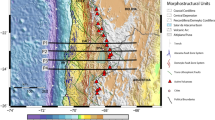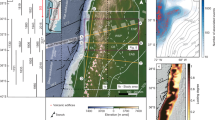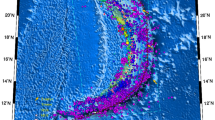Abstract
The role of fluids in earthquake rupture is key to understanding seismic hazards, particularly at subduction zones. The Shumagin Gap, Alaska, is notable due to a paucity of large earthquake nucleation and weak coupling between the overriding and subducting plates. Fluids have been hypothesized to explain these observations, but the source of the fluids remains unclear. Here we present an image of the subsurface electrical resistivity derived from marine magnetotelluric data collected in the Shumagin segment. The model reveals an approximately 50-km-wide conductive (that is, fluid-rich) zone near the plate interface with fluids sourced from the dehydration of slab mantle (15–25 km beneath the crust–mantle boundary). We find that the July 2020 megathrust earthquake—which nucleated near the Semidi segment and propagated westwards into the Shumagin segment—only ruptured the conductive portion of the plate interface. This suggests that slab mantle fluids can influence the seismogenic zone by, for example, creating patches that are prone to dynamic rupture. In contrast, updip of the slip patch is simultaneously resistive and weakly coupled, suggesting that fluids alone are not responsible for weak coupling and that plate roughness plays a role. More broadly, these results suggest that slab mantle fluids could be an underappreciated fluid source in the water budgets of forearc subduction zones.
This is a preview of subscription content, access via your institution
Access options
Access Nature and 54 other Nature Portfolio journals
Get Nature+, our best-value online-access subscription
$29.99 / 30 days
cancel any time
Subscribe to this journal
Receive 12 print issues and online access
$259.00 per year
only $21.58 per issue
Buy this article
- Purchase on Springer Link
- Instant access to full article PDF
Prices may be subject to local taxes which are calculated during checkout




Similar content being viewed by others
Data availability
Magnetotelluric impedance data and inversion model files are available via Figshare at https://doi.org/10.6084/m9.figshare.21751634.
Change history
09 October 2023
A Correction to this paper has been published: https://doi.org/10.1038/s41561-023-01313-0
References
Faccenda, M. Water in the slab: a trilogy. Tectonophysics 614, 1–30 (2014).
Saffer, D. M. & Tobin, H. J. Hydrogeology and mechanics of subduction zone forearcs: fluid flow and pore pressure. Annu Rev. Earth Planet Sci. 39, 157–186 (2011).
Abers, G. A., van Keken, P. E. & Wilson, C. R. Deep decoupling in subduction zones: observations and temperature limits. Geosphere 16, 1408–1424 (2020).
Heise, W. et al. Changes in electrical resistivity track changes in tectonic plate coupling. Geophys. Res. Lett. 40, 5029–5033 (2013).
Egbert, G. D. et al. Fluid transport and storage in the Cascadia forearc influenced by overriding plate lithology. Nat. Geosci. 15, 677–682 (2022).
Chesley, C., Naif, S., Key, K. & Bassett, D. Fluid-rich subducting topography generates anomalous forearc porosity. Nature 595, 255–260 (2021).
Heise, W. et al. Electrical resistivity imaging of the inter-plate coupling transition at the Hikurangi subduction margin, New Zealand. Earth Planet. Sci. Lett. 524, 115710 (2019).
Noda, H. & Lapusta, N. Stable creeping fault segments can become destructive as a result of dynamic weakening. Nature 493, 518–521 (2013).
Ichihara, H., Kasaya, T., Baba, K., Goto, T. & Yamano, M. 2D resistivity model around the rupture area of the 2011 Tohoku-oki earthquake (Mw 9.0). Earth Planets Space 75, 82 (2023).
Park, J. O., Naruse, H. & Bangs, N. L. Along-strike variations in the Nankai shallow décollement properties and their implications for tsunami earthquake generation. Geophys. Res. Lett. 41, 7057–7064 (2014).
Wang, K. & Bilek, S. L. Invited review paper: fault creep caused by subduction of rough seafloor relief. Tectonophysics 610, 1–24 (2014).
Davies, J., Sykes, L., House, L. & Jacob, K. Shumagin seismic gap, Alaska peninsula: history of great earthquakes, tectonic setting, and evidence for high seismic potential. J. Geophys. Res. 86, 3821–3855 (1981).
Li, S. & Freymueller, J. T. Spatial variation of slip behavior beneath the Alaska Peninsula along Alaska-Aleutian subduction zone. Geophys. Res. Lett. 45, 3453–3460 (2018).
Jiang, Y., González, P. J. & Bürgmann, R. Subduction earthquakes controlled by incoming plate geometry: the 2020 M > 7.5 Shumagin, Alaska, earthquake doublet. Earth Planet. Sci. Lett. 584, 117447 (2022).
Shillington, D. J. et al. Link between plate fabric, hydration and subduction zone seismicity in Alaska. Nat. Geosci. 8, 961–964 (2015).
Wei, S. S. et al. Along-strike variations in intermediate-depth seismicity and arc magmatism along the Alaska Peninsula. Earth Planet. Sci. Lett. 563, 116878 (2021).
Li, J. et al. Downdip variations in seismic reflection character: Implications for fault structure and seismogenic behavior in the Alaska subduction zone. J. Geophys. Res. Solid Earth 120, 7883–7904 (2015).
Bécel, A. et al. Tsunamigenic structures in a creeping section of the Alaska subduction zone. Nat. Geosci. 10, 609–613 (2017).
Shillington, D. J., Bécel, A. & Nedimović, M. R. Upper plate structure and megathrust properties in the Shumagin gap near the July 2020 M7.8 Simeonof event. Geophys. Res. Lett. 49, e2021GL096974 (2022).
Acquisto, T., Bécel, A., Singh, S. C. & Carton, H. Evidence of strong upper oceanic crustal hydration outboard the Alaskan and Sumatran subduction zones. J. Geophys. Res. Solid Earth 127, e2022JB024751 (2022).
Li, J. et al. Connections between subducted sediment, pore-fluid pressure, and earthquake behavior along the Alaska megathrust. Geology 46, 299–302 (2018).
Ye, L., Lay, T., Kanamori, H., Yamazaki, Y. & Cheung, K. F. The 22 July 2020 MW 7.8 Shumagin seismic gap earthquake: partial rupture of a weakly coupled megathrust. Earth Planet. Sci. Lett. 562, 116879 (2021).
Xiao, Z. et al. The deep Shumagin gap filled: kinematic rupture model and slip budget analysis of the 2020 Mw 7.8 Simeonof earthquake constrained by GNSS, global seismic waveforms, and floating InSAR. Earth Planet. Sci. Lett. 576, 117241 (2021).
Zhao, B. et al. Aseismic slip and recent ruptures of persistent asperities along the Alaska-Aleutian subduction zone. Nat. Commun. 13, 3098 (2022).
Liu, C., Lay, T., Xiong, X. & Wen, Y. Rupture of the 2020 Mw 7.8 earthquake in the Shumagin Gap inferred from seismic and geodetic observations. Geophys. Res. Lett. 47, e2020GL090806 (2020).
Cordell, D. et al. Magnetotelluric data and resistivity model for Shumagin Gap, Alaska. Figshare https://doi.org/10.6084/m9.figshare.21751634 (2022).
Naif, S., Key, K., Constable, S. & Evans, R. L. Water-rich bending faults at the Middle America Trench. Geochem. Geophys. Geosyst. 16, 2582–2597 (2015).
Cordell, D., Unsworth, M. J., Díaz, D. & Reyes-Wagner, V. Fluid and melt pathways in the Central Chilean subduction zone near the 2010 Maule earthquake (35–36°S) as inferred from magnetotelluric data. Geochem. Geophys. Geosyst. 20, 1–18 (2019).
Guo, X., Yoshino, T. & Katayama, I. Electrical conductivity anisotropy of deformed talc rocks and serpentinites at 3GPa. Phys. Earth Planet. Inter. 188, 69–81 (2011).
Aretusini, S., Meneghini, F., Spagnuolo, E., Harbord, C. W. & Di Toro, G. Fluid pressurisation and earthquake propagation in the Hikurangi subduction zone. Nat. Commun. 12, 2481 (2021).
Hatakeyama, K., Katayama, I., Hirauchi, K. I. & Michibayashi, K. Mantle hydration along outer-rise faults inferred from serpentinite permeability. Sci. Rep. 7, 13870 (2017).
Arnulf, A. F. et al. Upper-plate controls on subduction zone geometry, hydration and earthquake behaviour. Nat. Geosci. 15, 143–148 (2022).
Cai, C., Wiens, D. A., Shen, W. & Eimer, M. Water input into the Mariana subduction zone estimated from ocean-bottom seismic data. Nature 563, 389–392 (2018).
Berman, R. G., Engi, M., Greenwood, H. J. & Brown, T. H. Derivation of internally-consistent thermodynamic data by the technique of mathematical programming: a review with application the system MgO-SiO2-H2O. J. Petrol. 27, 1331–1364 (1986).
Hacker, B. R., Abers, G. A. & Peacock, S. M. Subduction factory 1. Theoretical mineralogy, densities, seismic wave speeds, and H2O contents. J. Geophys. Res. Solid Earth 108, 2029 (2003).
Perrillat, J. P. et al. Kinetics of antigorite dehydration: a real-time X-ray diffraction study. Earth Planet. Sci. Lett. 236, 899–913 (2005).
Padrón-Navarta, J. A., Hermann, J., Garrido, C. J., López Sánchez-Vizcaíno, V. & Gómez-Pugnaire, M. T. An experimental investigation of antigorite dehydration in natural silica-enriched serpentinite. Contrib. Mineral. Petrol. 159, 25–42 (2010).
Ulmer, P. & Trommsdorff, V. In Mantle Petrology: Field Observations and High Pressure Experimentation (A Tribute to Francis R. (Joe) Boyd) Special Publication No. 6 (eds Fei, Y. et al.), 259–281 (Geochemical Society, 1999).
Wunder, B. & Schreyer, W. Antigorite: high-pressure stability in the system MgO-SiO,-H,O (MSH). Lithos 41, 213–227 (1997).
Peacock, S. M. Advances in the thermal and petrologic modeling of subduction zones. Geosphere 16, 1647–1663 (2020).
Gutiérrez‐Aguilar, F., Hernández‐Uribe, D., Holder, R. M. & Condit, C. B. Fluid‐induced fault reactivation due to brucite + antigorite dehydration triggered the Mw 7.1 September 19th Puebla‐Morelos (Mexico) intermediate‐depth earthquake. Geophys. Res. Lett. 49, e2022GL100814 (2022).
Pattison, D. R. M., de Capitani, C. & Gaidies, F. Petrological consequences of variations in metamorphic reaction affinity. J. Metamorph. Geol. 29, 953–977 (2011).
Kohli, A. H. & Warren, J. M. Evidence for a deep hydrologic cycle on oceanic transform faults. J. Geophys. Res. Solid Earth 125, e2019JB017751 (2020).
Wright, N. M., Seton, M., Williams, S. E. & Müller, R. D. The Late Cretaceous to recent tectonic history of the Pacific Ocean basin. Earth Sci. Rev. 154, 138–173 (2016).
Zack, T. & John, T. An evaluation of reactive fluid flow and trace element mobility in subducting slabs. Chem. Geol. 239, 199–216 (2007).
Guo, H. & Keppler, H. Electrical conductivity of NaCl-bearing aqueous fluids to 900 °C and 5 GPa. J. Geophys. Res. Solid Earth 124, 1397–1411 (2019).
Korenaga, J. On the extent of mantle hydration caused by plate bending. Earth Planet. Sci. Lett. 457, 1–9 (2017).
Park, J. O. et al. Seismic reflection images of possible mantle-fluid conduits and basal erosion in the 2011 Tohoku earthquake rupture area. Front. Earth Sci. 9, 687382 (2021).
Wiersberg, T., Hammerschmidt, S. B., Fuchida, S., Kopf, A. & Erzinger, J. Mantle-derived fluids in the Nankai Trough Kumano forearc basin. Progr. Earth Planet. Sci. 5, 1–15 (2018).
Abers, G. A. Three-dimensional inversion of regional P and S arrival times in the East Aleutians and sources of subduction zone gravity highs. J. Geophys. Res. 99, 4395–4412 (1994).
USGS Earthquake Catalog 2010–2021 (Earthquake Hazards Program, United States Geological Survey, 2022); https://www.usgs.gov/programs/earthquake-hazards/earthquakes
Horowitz, W. L., Steffy, D. A., Hoose, P. J. & Turner, R. F. Geologic Report for the Shumagin Planning Area, Western Gulf of Alaska, United States Department of the Interior, Minerals Management Service (1989).
Hayes, G. P. et al. Slab2, a comprehensive subduction zone geometry model. Science 362, 58–61 (2018).
Ekström, G., Nettles, M. & Dziewoński, A. M. The global CMT project 2004-2010: centroid-moment tensors for 13,017 earthquakes. Phys. Earth Planet. Inter. 200–201, 1–9 (2012).
Ferrand, T. P. Seismicity and mineral destabilizations in the subducting mantle up to 6 GPa, 200 km depth. Lithos 334–335, 205–230 (2019).
Constable, S. Review paper: instrumentation for marine magnetotelluric and controlled source electromagnetic sounding. Geophys. Prospect. 61, 505–532 (2013).
Egbert, G. D. Robust multiple-station magnetotelluric data processing. Geophys. J. Int. 130, 475–496 (1997).
Key, K. MARE2DEM: a 2-D inversion code for controlled source electromagnetic and magnetotelluric data. Geophys. J. Int. 207, 571–588 (2016).
Ryan, W. B. F. et al. Global Multi-Resolution Topography (GMRT) synthesis data set. Geochem. Geophys. Geosyst. 10, Q03014 (2009).
Naif, S., Key, K., Constable, S. & Evans, R. L. Melt-rich channel observed at the lithosphere–asthenosphere boundary. Nature 495, 356–359 (2013).
Acknowledgements
We thank the captain and crew of RV Sikuliaq expedition SKQ201914S, the Scripps Marine EM Lab (C. Armerding, J. Lemire, J. Perez and J. Souders) and the EMAGE science party (T. Acquisto, J. Alvarez-Aramberri, J. Andrys, C. Armerding, E. Attias, G. Boren, B. Chase, C. Chesley, P. K. Miller, J. Perez, L. Wei and J. Zhu). This work was supported by the National Science Foundation under grant numbers OCE-1654652 to K.K., S.C., S.N. and D.S., and OCE-1654619 to R.E.
Author information
Authors and Affiliations
Contributions
K.K., R.E, S.C. and S.N. designed the experiment. K.K., S.C. and S.N. collected the data. S.N. processed the magnetotelluric responses. D.C. modelled the data, produced the figures and wrote the initial manuscript. All authors discussed the results and contributed to writing the manuscript.
Corresponding author
Ethics declarations
Competing interests
The authors declare no competing interests.
Peer review
Peer review information
Nature Geoscience thanks Yasuo Ogawa, Bo Yang and the other, anonymous, reviewer(s) for their contribution to the peer review of this work. Primary Handling Editors: Stefan Lachowycz and James Super, in collaboration with the Nature Geoscience team.
Additional information
Publisher’s note Springer Nature remains neutral with regard to jurisdictional claims in published maps and institutional affiliations.
Extended data
Extended Data Fig. 1 Dimensionality analysis using polar diagrams.
Dimensionality analysis using polar diagrams for the profile data.
Extended Data Fig. 2 Phase tensor ellipse pseudo-section.
Phase tensor ellipse pseudo-section along profile. Blue circular ellipses denote 1-D structure, whereas blue or yellow ellipses denote 2-D or pseudo-2-D structure. Red ellipses indicate 3-D structures. The data included in the inversion is indicated by the red boxes.
Extended Data Fig. 3 Dimensionality analysis using phase tensor.
Dimensionality analysis for the profile data using phase tensor. (a) Rose histogram showing phase tensor geoelectric strike angles for raw, un- edited dataset at all frequencies indicating no coherent strike direction. (b) Rose histogram showing phase tensor geoelectric strike angles for edited dataset at all frequencies indicating coherent strike direction of approximately 75°E of N. (c) Histogram of phase tensor skew angles for un-edited data at all frequencies with long tails to ±80°. (d) Histogram of phase tensor skew angles for edited data set at all frequencies with tighter distribution near 0°.
Extended Data Fig. 4 Convergence for the preferred inversion.
Convergence for the preferred inversion run40. Top left: r.m.s. misfit as a function of iteration. Top right panel: model roughness. Bottom left panel: iteration time. Bottom right panel: Lagrange multiplier search at each iteration step.
Extended Data Fig. 5 Data fits for the 30th iteration of run40.
Data fits for the 30th iteration of run40 with an overall r.m.s. misfit of 1.00. Red dots and blue dots are TM and TE mode data, respectively. Curves are the inversion response. Error bars on the data points are smaller than the data marker.
Extended Data Fig. 6 Breakdown of data misfit as a function of site, period, and impedance component.
Breakdown of data misfit as a function of: site NW to SE (top), period (middle), and impedance component (bottom) for the 30th iteration of run40 with an overall r.m.s. misfit of 1.00.
Extended Data Fig. 7 Inversion model which enforces a no smoothing constraint across the plate interface.
The model converged to an r.m.s. of 1.0 after 86 iterations.
Extended Data Fig. 8 Full model space of the preferred inversion model.
Full model space of the preferred inversion model (run40) showing the deeper conductor at 100 km depth.
Extended Data Fig. 9 Sensitivity tests for features C2, C3, and C4.
Sensitivity tests for features: (A) C2, (B) C3, and (C) C4. Each feature is replaced with 100 Ωm anomaly and then a forward simulation is run.
Extended Data Fig. 10 Results of sensitivity tests.
Results of sensitivity tests showing r.m.s. misfit changes as a function of site (top), period (middle), and impedance component (bottom).
Rights and permissions
Springer Nature or its licensor (e.g. a society or other partner) holds exclusive rights to this article under a publishing agreement with the author(s) or other rightsholder(s); author self-archiving of the accepted manuscript version of this article is solely governed by the terms of such publishing agreement and applicable law.
About this article
Cite this article
Cordell, D., Naif, S., Evans, R. et al. Forearc seismogenesis in a weakly coupled subduction zone influenced by slab mantle fluids. Nat. Geosci. 16, 822–827 (2023). https://doi.org/10.1038/s41561-023-01260-w
Received:
Accepted:
Published:
Issue Date:
DOI: https://doi.org/10.1038/s41561-023-01260-w



